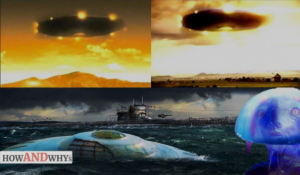ɴᴇᴡ ᴘʀᴏᴊᴇᴄᴛ ᴡɪʟʟ sᴇᴀʀᴄʜ ғᴏʀ ᴇxᴛʀᴀᴛᴇʀʀᴇsᴛʀɪᴀʟ ᴠɪsɪᴛᴏʀs ᴛᴏ ᴏᴜʀ sᴏʟᴀʀ sʏsᴛᴇᴍ

In 2017, a strangely shaped object whizzed past the Sun and Earth on a trajectory from beyond our Solar System, triggering wild speculation. Most scientists believe the cigar-shaped visitor, which measured less than a kilometer in length, was a comet or asteroid from a nearby star or some other cosmic flotsam. However, Harvard University theoretical physicist Avi Loeb claimed that ‘Oumuamua, Hawaiian for “scout,” was an a̳l̳i̳e̳n̳ creation—a light sail, antenna, or even a spaceship. He recently announced a plan to look for more such objects: a philanthropy-backed effort called the Galileo Project.
The project will use existing and new telescopes to search for mysterious artifacts such as hidden satellites in Earth orbit, natural or man-made interstellar objects, and even unexplained craft in Earth’s atmosphere.“It doesn’t really matter if it’s a natural artifact or a relic. If we look, we will find something new,” Loeb says.
Following the publication of Loeb’s book Extraterrestrial: The First Sign of Intelligent Life Beyond Earth, in which he claimed that ‘Oumuamua was some kind of a̳l̳i̳e̳n̳ technology, several wealthy individuals approached him—unsolicited—to offer funding for such research. Four of them eventually donated $1.75 million, allowing him to proceed with his plans. He put together a research team that included several well-known astronomers and other researchers, though he admits that not everyone he approached was open to the new ideas. “The science community should be open minded. That’s how we make progress,” Loeb says.

The project proposes looking for more objects like ‘Oumuamua using data from existing and upcoming survey telescopes, such as the 8-meter Vera C. Rubin Observatory currently under construction in Chile. Researchers will have more time to study incoming objects if they are detected early, rather than waiting the two months it took for ‘Oumuamua to pass out of telescope range. Loeb also hopes to design a launch-ready space mission to study an incomer up close in collaboration with space agencies or companies. “We should definitely be ready for the next ‘Oumuamua,” says astrophysicist Adam Frank of the University of Rochester. “We’ll learn a lot about these things whatever they are.”

Others wonder what the Galileo Project will add to ongoing searches for interstellar objects. Alan Fitzsimmons of Queen’s University Belfast, co-leader of the ‘Oumuamua investigation team organized by the International Space Science Institute, notes that existing alert networks already scour telescope data on an hourly basis in search of incoming interstellar objects. According to Fitzsimmons, the European Space Agency is developing a Comet Interceptor mission that will launch in 2028 and sit in orbit waiting for a suitable target, such as a comet or an interstellar object, before rushing out to meet it. “The community can’t wait for the discoveries of the Vera Rubin Observatory,” he says.

The Galileo Project also intends to search for e̳x̳t̳r̳a̳t̳e̳r̳r̳e̳s̳t̳r̳i̳a̳l̳ artifacts closer to home. Last month, the US director of national intelligence submitted a report to Congress outlining what is known about 144 reports of unidentified aerial phenomena (UAP), also known as unidentified flying objects, from military and intelligence sources. The report concluded that the majority of UAP were most likely physical objects rather than optical or atmospheric phenomena, but the data was so poor that it was impossible to determine whether they were “clutter” such as weather balloons and drones, still-secret programs run by US or foreign agencies, or something else. “The government is the most conservative organization you can think about,” Loeb says. For it to admit that it doesn’t know what UAP are is “a very significant statement.”
The Galileo Project will seek high-resolution images of UAP in order to learn more about them. According to Loeb, a 1-meter telescope with a modern sensor can see details as small as 1 millimeter on an object 1 kilometer away and can be ordered off the shelf for $500,000. If funds permit, he plans to place tens of telescopes in strategic locations around the world, scanning the skies for UAP with the help of radar and infrared sensors.

“It’s a reasonable question to ask, has the Earth been visited in its 4.5-billion-year history,” Frank says. If we discovered obvious signs of life on nearby exoplanets, we would send probes, he says. “Looking for artifacts [close to home] is a reasonable approach.” But other researchers balk at the idea that UAP have anything to do with SETI. “They don’t seem to have any obvious connection,” Wright says. Fitzsimmons was less diplomatic. “OK, that’s bollocks,” he says.
A third part of the project would involve using artificial intelligence techniques to process data from existing survey telescopes to look for e̳x̳t̳r̳a̳t̳e̳r̳r̳e̳s̳t̳r̳i̳a̳l̳ satellites in orbit around Earth. Government agencies already have sophisticated surveillance of everything in orbit around Earth larger than 10 centimeters in size, according to researchers. “The military is very good at that,” Wright says.
During his book promotion Loeb characterized his colleagues as blinkered and prejudiced against the search for a̳l̳i̳e̳n̳ relics and signals, known as technosignatures. Nor did he win fans for an ill-tempered exchange in February with SETI pioneer Jill Tarter. But he is more diplomatic now, acknowledging that his quest “takes people out of their comfort zone.”
But it’s “an exciting opportunity,” he says. “We’ll find whatever we find and look at the evidence.”







